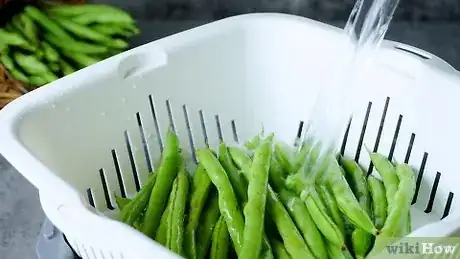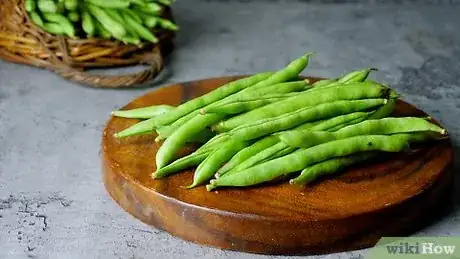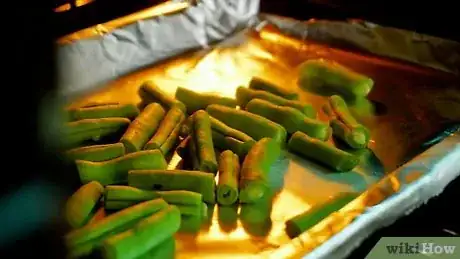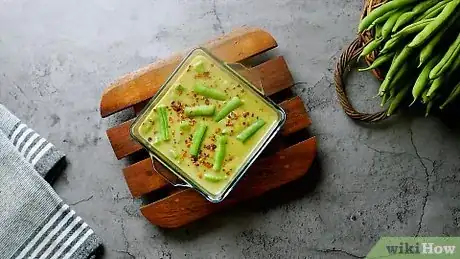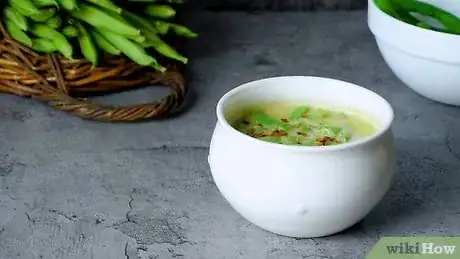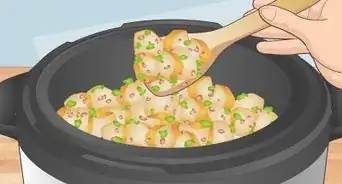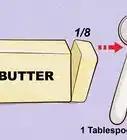This article was co-authored by Ollie George Cigliano. Ollie George Cigliano is a Private Chef, Food Educator, and Owner of Ollie George Cooks, based in Long Beach, California. With over 20 years of experience, she specializes in utilizing fresh, fun ingredients and mixing traditional and innovative cooking techniques. Ollie George holds a BA in Comparative Literature from The University of California, Berkeley, and a Nutrition and Healthy Living Certificate from eCornell University.
There are 13 references cited in this article, which can be found at the bottom of the page.
This article has been viewed 66,343 times.
Green beans are nutritious and delicious, and you can eat them in a variety of ways. You can snack on whole raw beans, eat them with your favorite dip, or toss them in with a salad. There are also many different ways you can cook green beans, including sautéing them for a tasty side dish or adding them to soups and casseroles. Preparing green beans for eating is quite simple, and all you have to do is rinse them and remove the stems.
Steps
Cleaning and Stemming the Beans
-
1Wash the beans. Transfer the beans to a colander and rinse them under running water. To remove dirt and other particles, you can rub the beans with your fingers while the water is running. Turn off the water and give the colander a shake to remove excess water.[1] Transfer the beans to a clean tea towel and pat them dry.
-
2Remove the stems by hand or with a knife. For smaller quantities of beans, you can remove the stems by hand. Firmly pinch the top of the bean just below the stem with your thumb and forefinger to remove the stem. You can leave the curly tail at the other end intact.[2]
- Use a knife to stem larger quantities of beans. Divide the beans in to manageable batches. Arrange each batch on a cutting board with all the stems lined up. Hold the beans in place and use a large chef’s knife to carefully trim off all the stems at once.
Advertisement -
3Don’t chop the green beans for side dishes. Green beans can be cooked in a variety of ways, including stir fried, sautéed, steamed, and more. When you're cooking green beans like this as a side dish or snack, you can leave the stemmed beans whole to help preserve more of their sweetness and crispness.[3]
-
4Chop the beans for adding to other dishes. When you're adding beans to other dishes, such as soups, salads, casseroles, it’s best to chop the beans into bite-sized pieces first. Line up a batch of beans on a cutting board and chop the beans into pieces that are 1 inch (2.5 cm) long.[4]
Blanching Green Beans
-
1Prepare the ice bath. Fill a large bowl halfway with ice. Fill the bowl the rest of the way with water.[5] Place the bowl beside the stove so you can access it easily when the beans have finished boiling.
- Blanching is the process of boiling vegetables for a short time and then stopping the cooking process quickly with an ice bath. It’s a good way to preserve a vegetable’s color, flavor, and texture before storage, and especially before freezing.
-
2Bring a pot of water to a boil. Fill a large saucepan with water and put on the lid. Bring the water to a boil over medium-high heat. You can add a tablespoon (19 g) of salt to the water as well if you want to season the beans slightly.[6]
-
3Boil the green beans for up to 4 minutes. Transfer the beans to the boiling water. With the lid off, bring the water back to a boil. Once the water starts boiling again, continue cooking the beans until they're slightly tender but still crisp.[7] Small beans will need about 2 minutes, whereas medium ones will need 3, and large ones will need 4.[8]
-
4Transfer the cooked beans to the ice bath. Remove the saucepan from the heat. Use a slotted spoon to remove the beans from the boiling water. Let the excess water drain from the beans before placing them into the ice bath. Chill the beans for 2 to 4 minutes, or the same amount of time it took to boil them.[9]
- Plunging the beans into the ice bath will immediately stop the cooking process.
-
5Drain the beans. When the beans have been chilled, transfer them to a colander to remove the water. Leave the beans in the colander for 5 to 10 minutes to drip and air dry.
- Once the beans have drained, they are ready to be eaten, cooked any way you like, or stored in the refrigerator or freezer.
Cooking Green Beans Different Ways
-
1Sauté them for a fresh and crisp side dish. Place 1 pound (450 g) of stemmed, blanched, and unchopped green beans in a large skillet. Add 3 tablespoons (44.4 ml) (43 g) of butter, and cook the beans on medium-low for about 2 minutes to warm them. Add 3 cloves of minced garlic, salt and pepper, to taste, and cook the beans for another 3 to 4 more minutes.[10]
-
2Steam them for softer green beans. Fill the steamer basket with 1 cup (125 g) of green beans per person. Fill the reservoir with water to the minimum fill line. Turn on the steamer and cook the beans for about 7 minutes, until they're tender but still have some crispness.[11]
- You can season steamed green beans with salt, pepper, lemon pepper, garlic powder, or any other herbs or spice you like.
- You can also use a portable metal steamer basket and cook the beans in a
-
3Microwave beans to cook them faster. Place 1 cup (125 g) of whole green beans into a microwave-safe bowl. Add 2 tablespoons (30 ml) of water and cover the bowl with a lid or plastic wrap. Open the lid slightly or peel off a corner of the plastic wrap to let steam escape. Microwave the beans on high for 3 to 4 minutes, until tender.[12]
-
4Roast them for a crisp and flavorful side dish. Spread the green beans out on a baking sheet lined with aluminum foil, parchment paper, or a silicone baking mat. Drizzle the beans with 1 tablespoon (15 ml) of olive oil and season them, to taste, with salt, pepper, and garlic powder. Bake the beans for 15 minutes in an oven that’s been preheated to 425 °F (218 °C). Flip the beans once during the cooking process.
-
5Bake them into a casserole. There are many different types of casseroles you can make, and you can add 1 cup (125 g) chopped green beans to just about any of them. Some popular casseroles that pair well with green beans include:
- Vegetable casseroles
- Rice casseroles
- Lasagna
- Taco casseroles
-
6Add them to soup. Many homemade meat soups, stews, and vegetable soups can be customized with the addition of chopped green beans. Add 1 cup (125 g) of green beans to any soup you like, such as:
- Broccoli
- Cream of chicken
- Minestrone
- Beef and barley
- Cream of asparagus
- Mushroom stew
Storing Green Beans
-
1Store fresh beans in the refrigerator for up to a week. You can store fresh green beans with the stems on, or you can wash and stem them first. Transfer the beans to a plastic bag and fold the top of the bag over once. Place the bag into the vegetable drawer of the refrigerator and store the beans for 5 to 7 days.[15]
- For washed and stemmed beans, wrap them in a sheet of paper towel before transferring them to the bag. This will absorb excess moisture and keep the beans from spoiling.[16]
- One effect of blanching is that it will help to extend the shelf life of your green beans, in part because it kills germs. Blanched green beans will last in the refrigerator for several days longer than unblanched beans.
-
2Freeze blanched beans for up to 10 months. After washing, stemming, blanching, and draining the beans, transfer them to an airtight freezer bag or other freezer-safe container. Seal the bag or put on the lid and transfer the beans to the freezer. The beans will last for 8 to 10 months.[17]
- It’s best to blanch beans before freezing, because this will help them retain their color, taste, and texture.
-
3Store cooked beans in the refrigerator for up to 5 days. Leftover beans that have been sautéed, stir fried, roasted, or otherwise cooked can be stored and eaten later. Transfer the leftovers to an airtight container and keep them chilled to preserve them.[18]
Community Q&A
Did you know you can get answers researched by wikiHow Staff?
Unlock staff-researched answers by supporting wikiHow
-
QuestionWhat should I look for when choosing green beans?
 wikiHow Staff EditorThis answer was written by one of our trained team of researchers who validated it for accuracy and comprehensiveness.
wikiHow Staff EditorThis answer was written by one of our trained team of researchers who validated it for accuracy and comprehensiveness.
Staff Answer wikiHow Staff EditorStaff AnswerPurchase green beans that have a bright color to them and that do not have any damage marks. A fresh bean will break easily when it is bent in half, while an old bean will tend to just bend without snapping. The beans should feel firm to the touch, which is a sign the bean is young, crisp, juicy and fresh. Avoid purchasing any beans that are wrinkled, limp or moldy.
wikiHow Staff EditorStaff AnswerPurchase green beans that have a bright color to them and that do not have any damage marks. A fresh bean will break easily when it is bent in half, while an old bean will tend to just bend without snapping. The beans should feel firm to the touch, which is a sign the bean is young, crisp, juicy and fresh. Avoid purchasing any beans that are wrinkled, limp or moldy. -
QuestionAre green beans healthy for you?
 wikiHow Staff EditorThis answer was written by one of our trained team of researchers who validated it for accuracy and comprehensiveness.
wikiHow Staff EditorThis answer was written by one of our trained team of researchers who validated it for accuracy and comprehensiveness.
Staff Answer wikiHow Staff EditorStaff Answer
wikiHow Staff EditorStaff Answer -
QuestionIs it okay to used canned green beans?
 wikiHow Staff EditorThis answer was written by one of our trained team of researchers who validated it for accuracy and comprehensiveness.
wikiHow Staff EditorThis answer was written by one of our trained team of researchers who validated it for accuracy and comprehensiveness.
Staff Answer wikiHow Staff EditorStaff AnswerFresh green beans and canned green beans are like chalk and cheese. Fresh green beans are juicy, crisp and crunch. Canned green beans are soft, mushy and quite bland. One possible exception: Home preserved green beans made immediately after harvest may taste just fine, depending on the preserving process used. It really depends on what you're using the beans for; if camping, making a mushy stew or getting nostalgic about your grandparent's overcooked dinners, then by all means use canned green beans. But if you really want tasty, fresh and crispy flavored green beans, the fresh ones win every time.
wikiHow Staff EditorStaff AnswerFresh green beans and canned green beans are like chalk and cheese. Fresh green beans are juicy, crisp and crunch. Canned green beans are soft, mushy and quite bland. One possible exception: Home preserved green beans made immediately after harvest may taste just fine, depending on the preserving process used. It really depends on what you're using the beans for; if camping, making a mushy stew or getting nostalgic about your grandparent's overcooked dinners, then by all means use canned green beans. But if you really want tasty, fresh and crispy flavored green beans, the fresh ones win every time.
Expert Interview
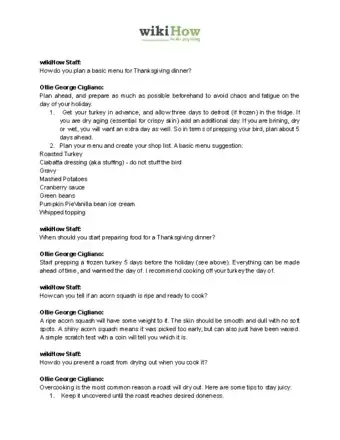
Thanks for reading our article! If you'd like to learn more about cooking, check out our in-depth interview with Ollie George Cigliano.
References
- ↑ http://www.thekitchn.com/how-to-cook-green-beans-234738
- ↑ https://www.youtube.com/watch?v=fg9219FvCvM
- ↑ https://whatscookingamerica.net/Q-A/GreenBeans.htm
- ↑ http://www.bhg.com/recipes/how-to/cook-with-fruits-and-vegetables/how-to-cook-green-beans/
- ↑ https://www.thekitchn.com/how-to-blanch-vegetables-home-108570
- ↑ http://www.bhg.com/recipes/how-to/cook-with-fruits-and-vegetables/how-to-cook-green-beans/
- ↑ https://www.youtube.com/watch?v=fg9219FvCvM
- ↑ http://www.bhg.com/recipes/how-to/preserving-canning/freeze-green-beans/
- ↑ https://whatscookingamerica.net/Q-A/GreenBeans.htm
- ↑ http://allrecipes.com/recipe/230103/buttery-garlic-green-beans/
- ↑ http://www.foodnetwork.com/recipes/steamed-green-beans-recipe0-1950772/
- ↑ https://whatscookingamerica.net/Q-A/GreenBeans.htm
- ↑ https://www.skinnytaste.com/roasted-parmesan-green-beans/
- ↑ https://www.thekitchn.com/the-best-oils-for-roasting-236653
- ↑ https://www.eatbydate.com/vegetables/fresh-vegetables/green-beans/
- ↑ http://www.latimes.com/food/la-fo-green-beans-s-story.html
- ↑ https://www.eatbydate.com/vegetables/frozen-vegetables-shelf-life-expiration-date/
- ↑ http://www.thekitchn.com/how-to-cook-green-beans-234738
